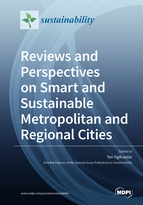Reviews and Perspectives on Smart and Sustainable Metropolitan and Regional Cities
A special issue of Sustainability (ISSN 2071-1050). This special issue belongs to the section "Sustainable Urban and Rural Development".
Deadline for manuscript submissions: closed (30 September 2021) | Viewed by 73142
Special Issue Editor
Interests: smart technologies, communities, cities and urbanism; knowledge-based development of cities and innovation districts; sustainable and resilient cities; communities and urban ecosystems
Special Issues, Collections and Topics in MDPI journals
Special Issue Information
Dear Colleagues,
The increasing severity and frequency of climate change effects, biodiversity loss, natural disasters, pandemics, and socioeconomic inequalities have heightened the necessity of developing cities which are smart and sustainable. The smart and sustainable cities notion, in both metropolitan and regional contexts, offers an integrated and holistic approach to urbanism by aiming to achieve the long-term goals of urban sustainability and resilience. In essence, a smart and sustainable city is an urban locality functioning as a robust system of systems with sustainable practices—supported by community, technology and policy—to generate desired outcomes and futures for all humans and non-humans.
This Special Issue will contribute to improving research and practice in smart and sustainable metropolitan and regional cities and urbanism by bringing together literature review and scholarly perspective pieces, and forming an open access knowledge warehouse. This Special Issue seeks contributions—in the form of scientometric analyses, bibliometric analyses, meta-analyses, systematic literature reviews, thorough best practice and policy reviews, opinion pieces, commentaries, perspectives, and viewpoints—offering insights into research and practice in smart and sustainable metropolitan and regional cities by producing in-depth conceptual debates and perspectives, insights from the literature and best practice, and throroughly identified research themes and development trends. This Special Issue will serve as a repository of relevant information, material, and knowledge to support research, policymaking, practice, and transferability of experiences to address the challenges in establishing smart and sustainable metropolitan and regional cities and urbanism in the era of climate change, biodiversity collapse, natural disasters, pandemics, and socioeconomic inequalities.
The scope of the Special Issue—that compiles the pioneering work of researchers and scholarly literature collections—includes the following broad areas and analysis types, although other relevant topics will also be considered:
- Scientometric, bibliometric, and meta-analyses on issues relevant to smart and sustainable metropolitan and regional cities and urbanism;
- Systematic, argumentative, integrative, historical, methodological, and theoretical literature reviews on issues relevant to smart and sustainable metropolitan and regional cities and urbanism;
- Global best and good practice and policy analyses and reviews on issues relevant to smart and sustainable metropolitan and regional cities and urbanism;
- Opinion pieces, commentaries, comments, perspectives, and viewpoints on issues relevant to smart and sustainable metropolitan and regional cities and urbanism.
Prof. Dr. Tan Yigitcanlar
Guest Editor
Manuscript Submission Information
Manuscripts should be submitted online at www.mdpi.com by registering and logging in to this website. Once you are registered, click here to go to the submission form. Manuscripts can be submitted until the deadline. All submissions that pass pre-check are peer-reviewed. Accepted papers will be published continuously in the journal (as soon as accepted) and will be listed together on the special issue website. Research articles, review articles as well as short communications are invited. For planned papers, a title and short abstract (about 100 words) can be sent to the Editorial Office for announcement on this website.
Submitted manuscripts should not have been published previously, nor be under consideration for publication elsewhere (except conference proceedings papers). All manuscripts are thoroughly refereed through a single-blind peer-review process. A guide for authors and other relevant information for submission of manuscripts is available on the Instructions for Authors page. Sustainability is an international peer-reviewed open access semimonthly journal published by MDPI.
Please visit the Instructions for Authors page before submitting a manuscript. The Article Processing Charge (APC) for publication in this open access journal is 2400 CHF (Swiss Francs). Submitted papers should be well formatted and use good English. Authors may use MDPI's English editing service prior to publication or during author revisions.
Keywords
- sustainable urban development
- sustainable development
- sustainable cities
- sustainable urbanism
- smart urbanism
- smart cities
- metropitan cities
- regional cities
- regional towns
- lifestyle towns
- regional disparities
- urban resilience
- climate change
- regionalism
- pandemic sensitive cities
- urban infrastructure
- urban technology
- urban governance
- urban and regional planning
- rural area planning






